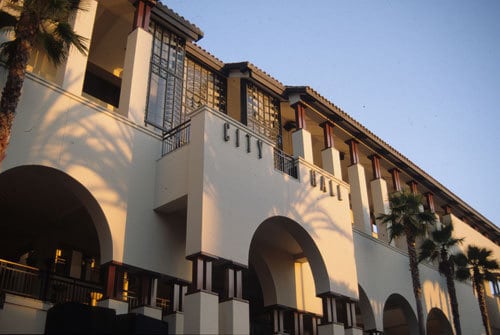
Towards the end of the seven hour long meeting on Monday, April 24, 2023, the Culver City council voted along the expected 3 to 2 split to end the protected bike lanes that are part of the downtown MOVE transit project, approving increased car traffic as “Option 3” out of the possibilities presented by staff to continue the project.
The choice to add more vehicle traffic seemed absurd in the face of the city’s own report – numbers along every measurable standard were positive. The report showed that bus ridership was increased, bike use increased and also showed a substantial raise in consumer spending along the corridor. There was no empirical evidence to support adding more car traffic back into the 1.3 mile corridor of the project.
The presentation from city staff, led by Chief of Transportation Diana Chang and Public Works Director Yanni Dimitri, looked at the entire project from the original plan to the installation of the pilot program to the current results. Chang began the presentation noting that one of the goals of the project was to “minimize vehicular impact.”
The options for the next phase of the downtown project were offered as Option One – Permanent Vision; keep the project as is, Option Two – Light Touch; continue making changes in response to community feedback, or Option Three – remove the protected bike lane and fold bike and bus traffic into a single lane, adding back a second lane for car traffic.
The city has also just been awarded a grant for $3.25 million micro-transit, enhancing the ability of the city to continue the circulator bus and add another circulator on Jefferson Boulevard. There are also plans for an ‘on-demand’ transit app (like Lyft or Uber) that would allow residents to use their phones to hail Culver City transit ride.
The deeply detailed report (beginning on the YouTube video of the council meeting at 1:28) reflected the success of the project; even comparing vehicle traffic to 2019, before MOVE was created, it showed travel times as one minute faster during morning rush hours, and two minutes slower during evening rush hours. For buses and bikes, the positives were clear.
Elected officials from state, county and nearby cities had all publicly expressed their support for MOVE, including Assembly member Issac Bryan, LA County Supervisors Holly Mitchell and Lindsay Horvath, along with West Hollywood’s John Erikson and Katy Yaroslavsky of Los Angeles. Multiple organizations threatening to sue using the California Environmental Quality Act, including the National Resources Defense Council, did not deter the council member from their decision.
The meeting was the most heavily attended in many years, with over 200 people signed up to speak to the agenda item. An overwhelming majority of those who spoke – including many students, some as young as grade school – talked about the bike lanes as a great way to get around. A signed banner was presented to the council as a way of showing even broader support among students.
But the enthusiasm for the success of the project was by no means unanimous. Darrel Menthe, the Executive Director of the Downtown Business Association, spoke to the meeting with a lengthy list of businesses that he said were unhappy with the MOVE project. “Downtown business need to see some changes.”‘ Owners of several restaurants on the corridor, including Akasha and Pasta Sisters, noted their opposition.
Thistle Boosinger’s comments reflected the majority of the speakers, noting that “hundreds of people showed up in support of this. Unprecedented amounts of support. I hope you all took notes during the presentation because this is a resounding success in every single aspect.”
When it came time for the council to vote, it was clear that the council majority had little interest in any of the positive evidence presented, nor seemingly any concern over the legal storm-front gathering in response.
Mayor Albert Vera, Jr. “We need alternatives, we need different means of transportation…ultimately we want the same thing …I think Option 3 is a compromise looking forward.”
The exact language of Option 3 as presented in the motion was “Continue with the pilot project for a minimum of two years, modifying the corridor design to add vehicle capacity where it is needed and preserve a protected shared bus/bike lane throughout.”
The vote was Mayor Vera, Jr., Council member Eriksson, and Council member O’Brien in favor, and Vice Mayor McMorrin, and Council member Puza opposed.
Judith Martin-Straw

